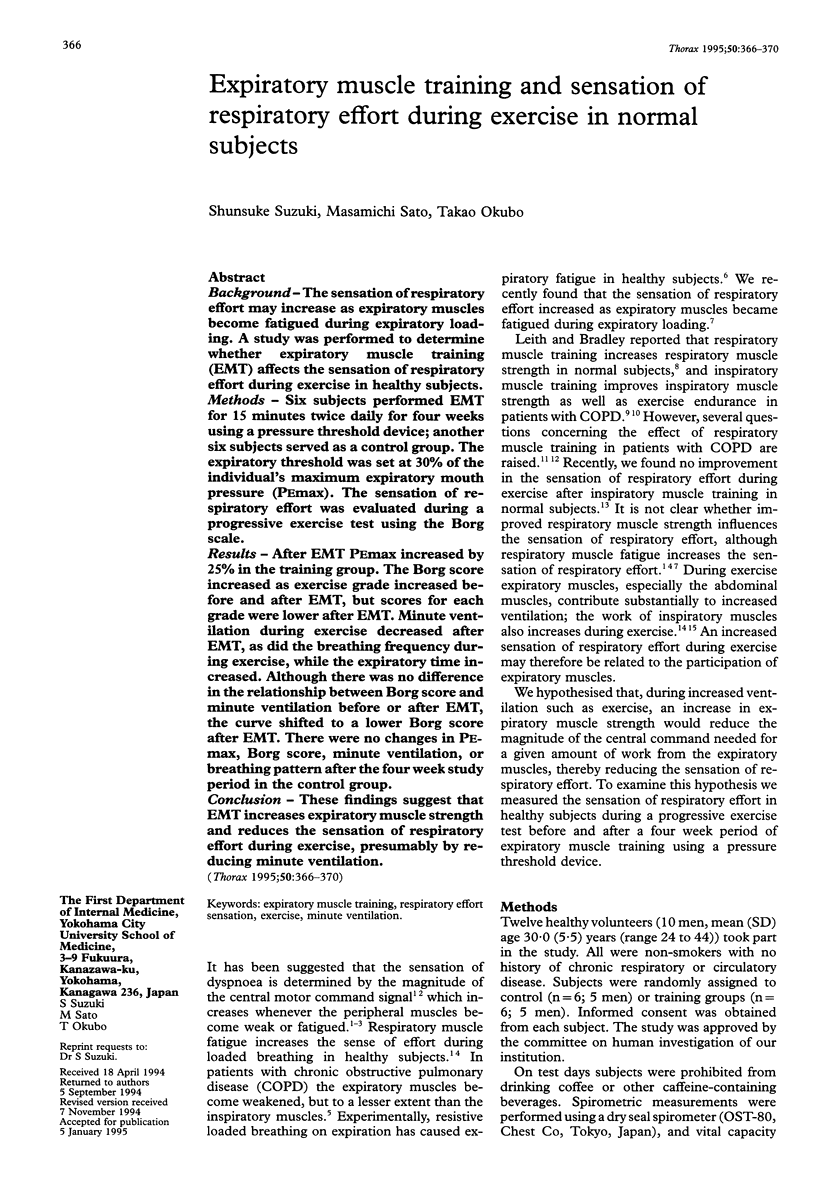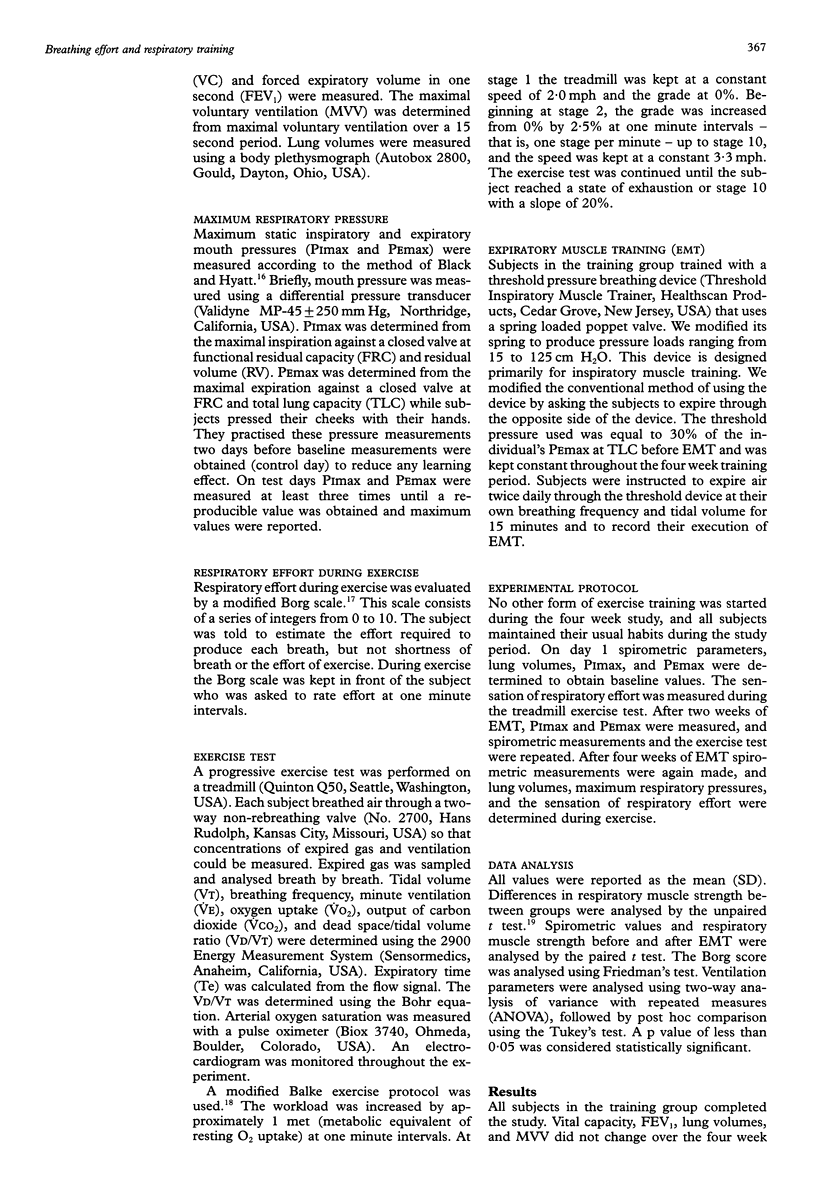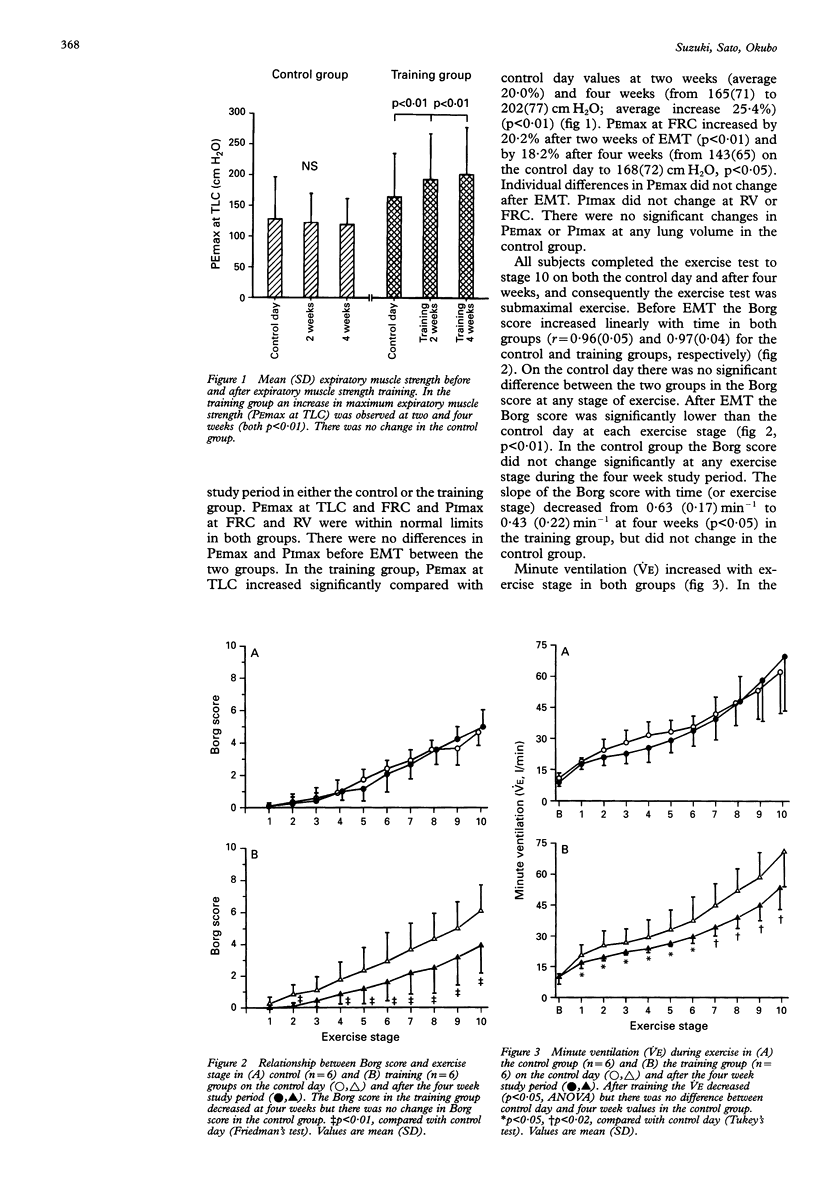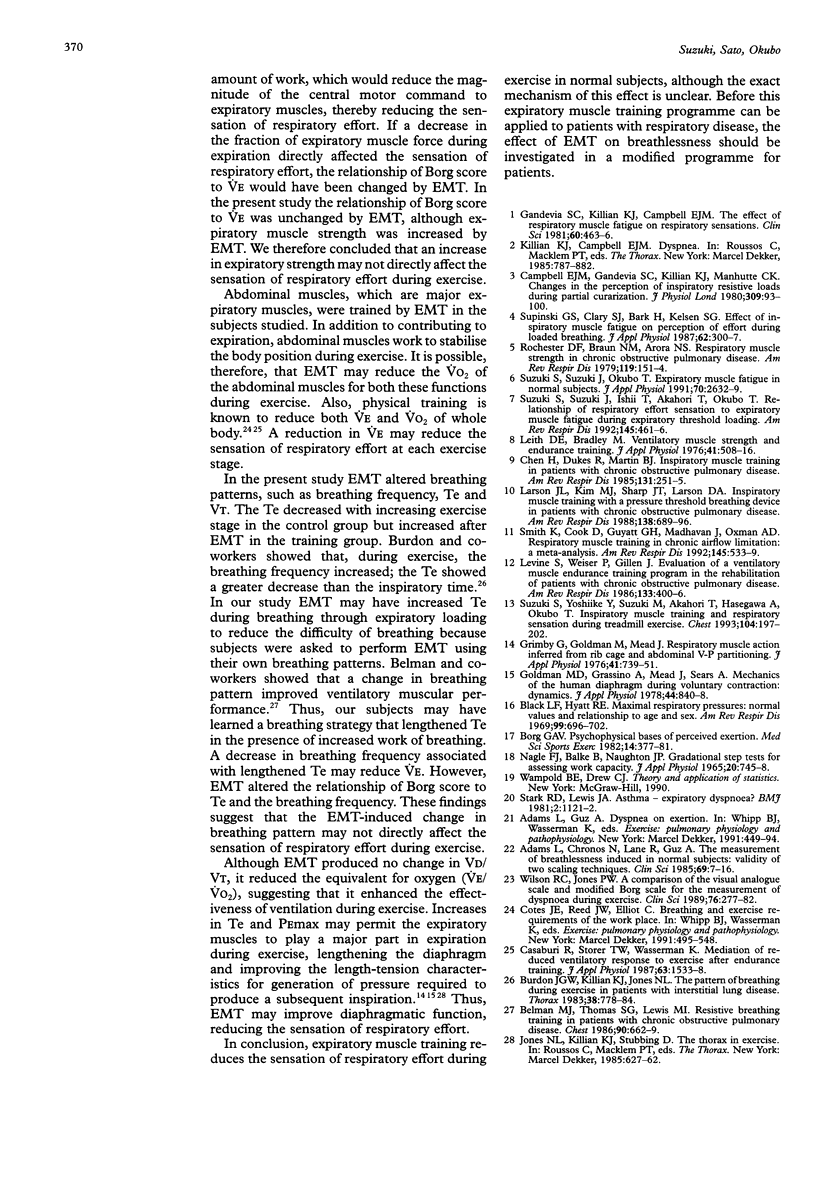Abstract
BACKGROUND--The sensation of respiratory effort may increase as expiratory muscles become fatigued during expiratory loading. A study was performed to determine whether expiratory muscle training (EMT) affects the sensation of respiratory effort during exercise in healthy subjects. METHODS--Six subjects performed EMT for 15 minutes twice daily for four weeks using a pressure threshold device; another six subjects served as a control group. The expiratory threshold was set at 30% of the individual's maximum expiratory mouth pressure (PEmax). The sensation of respiratory effort was evaluated during a progressive exercise test using the Borg scale. RESULTS--After EMT PEmax increased by 25% in the training group. The Borg score increased as exercise grade increased before and after EMT, but scores for each grade were lower after EMT. Minute ventilation during exercise decreased after EMT, as did the breathing frequency during exercise, while the expiratory time increased. Although there was no difference in the relationship between Borg score and minute ventilation before or after EMT, the curve shifted to a lower Borg score after EMT. There were no changes in PEmax, Borg score, minute ventilation, or breathing pattern after the four week study period in the control group. CONCLUSION--These findings suggest that EMT increases expiratory muscle strength and reduces the sensation of respiratory effort during exercise, presumably by reducing minute ventilation.
Full text
PDF




Selected References
These references are in PubMed. This may not be the complete list of references from this article.
- Adams L., Chronos N., Lane R., Guz A. The measurement of breathlessness induced in normal subjects: validity of two scaling techniques. Clin Sci (Lond) 1985 Jul;69(1):7–16. doi: 10.1042/cs0690007. [DOI] [PubMed] [Google Scholar]
- Belman M. J., Thomas S. G., Lewis M. I. Resistive breathing training in patients with chronic obstructive pulmonary disease. Chest. 1986 Nov;90(5):662–669. doi: 10.1378/chest.90.5.662. [DOI] [PubMed] [Google Scholar]
- Black L. F., Hyatt R. E. Maximal respiratory pressures: normal values and relationship to age and sex. Am Rev Respir Dis. 1969 May;99(5):696–702. doi: 10.1164/arrd.1969.99.5.696. [DOI] [PubMed] [Google Scholar]
- Borg G. A. Psychophysical bases of perceived exertion. Med Sci Sports Exerc. 1982;14(5):377–381. [PubMed] [Google Scholar]
- Burdon J. G., Killian K. J., Jones N. L. Pattern of breathing during exercise in patients with interstitial lung disease. Thorax. 1983 Oct;38(10):778–784. doi: 10.1136/thx.38.10.778. [DOI] [PMC free article] [PubMed] [Google Scholar]
- Campbell E. J., Gandevia S. C., Killian K. J., Mahutte C. K., Rigg J. R. Changes in the perception of inspiratory resistive loads during partial curarization. J Physiol. 1980 Dec;309:93–100. doi: 10.1113/jphysiol.1980.sp013496. [DOI] [PMC free article] [PubMed] [Google Scholar]
- Casaburi R., Storer T. W., Wasserman K. Mediation of reduced ventilatory response to exercise after endurance training. J Appl Physiol (1985) 1987 Oct;63(4):1533–1538. doi: 10.1152/jappl.1987.63.4.1533. [DOI] [PubMed] [Google Scholar]
- Chen H., Dukes R., Martin B. J. Inspiratory muscle training in patients with chronic obstructive pulmonary disease. Am Rev Respir Dis. 1985 Feb;131(2):251–255. doi: 10.1164/arrd.1985.131.2.251. [DOI] [PubMed] [Google Scholar]
- Gandevia S. C., Killian K. J., Campbell E. J. The effect of respiratory muscle fatigue on respiratory sensations. Clin Sci (Lond) 1981 Apr;60(4):463–466. doi: 10.1042/cs0600463. [DOI] [PubMed] [Google Scholar]
- Goldman M. D., Grassino A., Mead J., Sears T. A. Mechanics of the human diaphragm during voluntary contraction: dynamics. J Appl Physiol Respir Environ Exerc Physiol. 1978 Jun;44(6):840–848. doi: 10.1152/jappl.1978.44.6.840. [DOI] [PubMed] [Google Scholar]
- Grimby G., Goldman M., Mead J. Respiratory muscle action inferred from rib cage and abdominal V-P partitioning. J Appl Physiol. 1976 Nov;41(5 Pt 1):739–751. doi: 10.1152/jappl.1976.41.5.739. [DOI] [PubMed] [Google Scholar]
- Larson J. L., Kim M. J., Sharp J. T., Larson D. A. Inspiratory muscle training with a pressure threshold breathing device in patients with chronic obstructive pulmonary disease. Am Rev Respir Dis. 1988 Sep;138(3):689–696. doi: 10.1164/ajrccm/138.3.689. [DOI] [PubMed] [Google Scholar]
- Leith D. E., Bradley M. Ventilatory muscle strength and endurance training. J Appl Physiol. 1976 Oct;41(4):508–516. doi: 10.1152/jappl.1976.41.4.508. [DOI] [PubMed] [Google Scholar]
- Levine S., Weiser P., Gillen J. Evaluation of a ventilatory muscle endurance training program in the rehabilitation of patients with chronic obstructive pulmonary disease. Am Rev Respir Dis. 1986 Mar;133(3):400–406. doi: 10.1164/arrd.1986.133.3.400. [DOI] [PubMed] [Google Scholar]
- Nagle F. J., Balke B., Naughton J. P. Gradational step tests for assessing work capacity. J Appl Physiol. 1965 Jul;20(4):745–748. doi: 10.1152/jappl.1965.20.4.745. [DOI] [PubMed] [Google Scholar]
- Rochester D. F., Braun N. M., Arora N. S. Respiratory muscle strength in chronic obstructive pulmonary disease. Am Rev Respir Dis. 1979 Feb;119(2 Pt 2):151–154. doi: 10.1164/arrd.1979.119.2P2.151. [DOI] [PubMed] [Google Scholar]
- Smith K., Cook D., Guyatt G. H., Madhavan J., Oxman A. D. Respiratory muscle training in chronic airflow limitation: a meta-analysis. Am Rev Respir Dis. 1992 Mar;145(3):533–539. doi: 10.1164/ajrccm/145.3.533. [DOI] [PubMed] [Google Scholar]
- Supinski G. S., Clary S. J., Bark H., Kelsen S. G. Effect of inspiratory muscle fatigue on perception of effort during loaded breathing. J Appl Physiol (1985) 1987 Jan;62(1):300–307. doi: 10.1152/jappl.1987.62.1.300. [DOI] [PubMed] [Google Scholar]
- Suzuki S., Suzuki J., Ishii T., Akahori T., Okubo T. Relationship of respiratory effort sensation to expiratory muscle fatigue during expiratory threshold loading. Am Rev Respir Dis. 1992 Feb;145(2 Pt 1):461–466. doi: 10.1164/ajrccm/145.2_Pt_1.461. [DOI] [PubMed] [Google Scholar]
- Suzuki S., Suzuki J., Okubo T. Expiratory muscle fatigue in normal subjects. J Appl Physiol (1985) 1991 Jun;70(6):2632–2639. doi: 10.1152/jappl.1991.70.6.2632. [DOI] [PubMed] [Google Scholar]
- Suzuki S., Yoshiike Y., Suzuki M., Akahori T., Hasegawa A., Okubo T. Inspiratory muscle training and respiratory sensation during treadmill exercise. Chest. 1993 Jul;104(1):197–202. doi: 10.1378/chest.104.1.197. [DOI] [PubMed] [Google Scholar]
- Wilson R. C., Jones P. W. A comparison of the visual analogue scale and modified Borg scale for the measurement of dyspnoea during exercise. Clin Sci (Lond) 1989 Mar;76(3):277–282. doi: 10.1042/cs0760277. [DOI] [PubMed] [Google Scholar]


